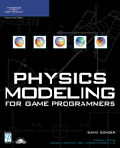| Меню сайта |
| Наше опитування |
| Реклама від Google |
|
Главная » 2009 Лютий 28 » Physics Modeling for Game Programmers [en]
Physics Modeling for Game Programmers [en] | 20:58 |
 Paperback: 544 pages Доступно тільки для користувачів
Publisher: Course Technology PTR; 1 edition (August 12, 2004) Language: English ISBN-10: 1592000932 ISBN-13: 978-1592000937 Programmers who want to include 3D math and physics in a game have to wade through physics textbooks and dreary tomes on linear algebra and group theory, only to find that the material is too abstract to be used directly in their games. This book gives readers the skills they want and need to incorporate real physics into their games. As they work through the book, they will constantly develop tools, demos, and working games. The highly graphical demos ensure that instead of just reading about how to calculate the trajectory of a projectile, the reader will actually see a canon firing rounds toward the front lines. From the successful Game Development series, this book thoroughly addresses the specific needs of game developers. From the Publisher Physics modeling is taking the game development industry by storm. It is a powerful too for producing great-looking, realistic games. A simple model can create effects beyond the wildest expectations. Advances in processing speed and 3D rendering technology have revolutionized games. A good understanding of the underlying physics and how to implement it as a programmer are essential to making a really good 3D game. | |
| Категория: Математика і фізика | Просмотров: 645 | Добавил: Admin | Рейтинг: 0.0/0 | | |
| Всего комментариев: 0 | |
| Форма входа |
| Календар новин | ||||||||||||||||||||||||||||||||||||||||||||||||
| ||||||||||||||||||||||||||||||||||||||||||||||||
| Пошук |
|
|
| Статистика |
|
Онлайн всього 1 Гостей 1 Користувачів 0 |